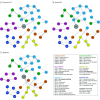Polygenic Scores and Networks of Psychopathology Symptoms
- PMID: 38865107
- PMCID: PMC11170456
- DOI: 10.1001/jamapsychiatry.2024.1403
Polygenic Scores and Networks of Psychopathology Symptoms
Erratum in
-
Change to Open Access.JAMA Psychiatry. 2024 Sep 1;81(9):948. doi: 10.1001/jamapsychiatry.2024.2537. JAMA Psychiatry. 2024. PMID: 39230613 Free PMC article. No abstract available.
Abstract
Importance: Studies on polygenic risk for psychiatric traits commonly use a disorder-level approach to phenotyping, implicitly considering disorders as homogeneous constructs; however, symptom heterogeneity is ubiquitous, with many possible combinations of symptoms falling under the same disorder umbrella. Focusing on individual symptoms may shed light on the role of polygenic risk in psychopathology.
Objective: To determine whether polygenic scores are associated with all symptoms of psychiatric disorders or with a subset of indicators and whether polygenic scores are associated with comorbid phenotypes via specific sets of relevant symptoms.
Design, setting, and participants: Data from 2 population-based cohort studies were used in this cross-sectional study. Data from children in the Avon Longitudinal Study of Parents and Children (ALSPAC) were included in the primary analysis, and data from children in the Twins Early Development Study (TEDS) were included in confirmatory analyses. Data analysis was conducted from October 2021 to January 2024. Pregnant women based in the Southwest of England due to deliver in 1991 to 1992 were recruited in ALSPAC. Twins born in 1994 to 1996 were recruited in TEDS from population-based records. Participants with available genetic data and whose mothers completed the Short Mood and Feelings Questionnaire and the Strength and Difficulties Questionnaire when children were 11 years of age were included.
Main outcomes and measures: Psychopathology relevant symptoms, such as hyperactivity, prosociality, depression, anxiety, and peer and conduct problems at age 11 years. Psychological networks were constructed including individual symptoms and polygenic scores for depression, anxiety, attention-deficit/hyperactivity disorder (ADHD), body mass index (BMI), and educational attainment in ALSPAC. Following a preregistered confirmatory analysis, network models were cross-validated in TEDS.
Results: Included were 5521 participants from ALSPAC (mean [SD] age, 11.8 [0.14] years; 2777 [50.3%] female) and 4625 participants from TEDS (mean [SD] age, 11.27 [0.69] years; 2460 [53.2%] female). Polygenic scores were preferentially associated with restricted subsets of core symptoms and indirectly associated with other, more distal symptoms of psychopathology (network edges ranged between r = -0.074 and r = 0.073). Psychiatric polygenic scores were associated with specific cross-disorder symptoms, and nonpsychiatric polygenic scores were associated with a variety of indicators across disorders, suggesting a potential contribution of nonpsychiatric traits to comorbidity. For example, the polygenic score for ADHD was associated with a core ADHD symptom, being easily distracted (r = 0.07), and the polygenic score for BMI was associated with symptoms across disorders, including being bullied (r = 0.053) and not thinking things out (r = 0.041).
Conclusions and relevance: Genetic associations observed at the disorder level may hide symptom-level heterogeneity. A symptom-level approach may enable a better understanding of the role of polygenic risk in shaping psychopathology and comorbidity.
Conflict of interest statement
Figures



Similar articles
-
Association of Genetic Risk Factors for Psychiatric Disorders and Traits of These Disorders in a Swedish Population Twin Sample.JAMA Psychiatry. 2019 Mar 1;76(3):280-289. doi: 10.1001/jamapsychiatry.2018.3652. JAMA Psychiatry. 2019. PMID: 30566181 Free PMC article.
-
Polygenic risk for mental disorder reveals distinct association profiles across social behaviour in the general population.Mol Psychiatry. 2022 Mar;27(3):1588-1598. doi: 10.1038/s41380-021-01419-0. Epub 2022 Feb 28. Mol Psychiatry. 2022. PMID: 35228676 Free PMC article.
-
Genetic Associations Between Childhood Psychopathology and Adult Depression and Associated Traits in 42 998 Individuals: A Meta-analysis.JAMA Psychiatry. 2020 Jul 1;77(7):715-728. doi: 10.1001/jamapsychiatry.2020.0527. JAMA Psychiatry. 2020. PMID: 32293669 Free PMC article.
-
Overview of CAPICE-Childhood and Adolescence Psychopathology: unravelling the complex etiology by a large Interdisciplinary Collaboration in Europe-an EU Marie Skłodowska-Curie International Training Network.Eur Child Adolesc Psychiatry. 2022 May;31(5):829-839. doi: 10.1007/s00787-020-01713-2. Epub 2021 Jan 20. Eur Child Adolesc Psychiatry. 2022. PMID: 33474652 Free PMC article. Review.
-
Research Review: How to interpret associations between polygenic scores, environmental risks, and phenotypes.J Child Psychol Psychiatry. 2022 Oct;63(10):1125-1139. doi: 10.1111/jcpp.13607. Epub 2022 Mar 28. J Child Psychol Psychiatry. 2022. PMID: 35347715 Free PMC article. Review.
Cited by
-
ADHD symptom trajectories across childhood and early adolescence and risk for hypomanic symptoms in young adulthood.Eur Psychiatry. 2025 Feb 19;68(1):e37. doi: 10.1192/j.eurpsy.2025.24. Eur Psychiatry. 2025. PMID: 39967022 Free PMC article.
-
From triple-mode network to triple-layered model - novel insights in social cognition.Indian J Psychiatry. 2025 Jul;67(7):710-720. doi: 10.4103/indianjpsychiatry_446_25. Epub 2025 Jul 15. Indian J Psychiatry. 2025. PMID: 40786216 Free PMC article.
-
Change to Open Access.JAMA Psychiatry. 2024 Sep 1;81(9):948. doi: 10.1001/jamapsychiatry.2024.2537. JAMA Psychiatry. 2024. PMID: 39230613 Free PMC article. No abstract available.
References
-
- Cai N, Revez JA, Adams MJ, et al. . Minimal phenotyping yields GWAS hits of reduced specificity for major depression. bioRxiv. Preprint posted online November 4, 2019. doi:10.1101/440735 - DOI
Publication types
MeSH terms
Grants and funding
LinkOut - more resources
Full Text Sources
Medical

